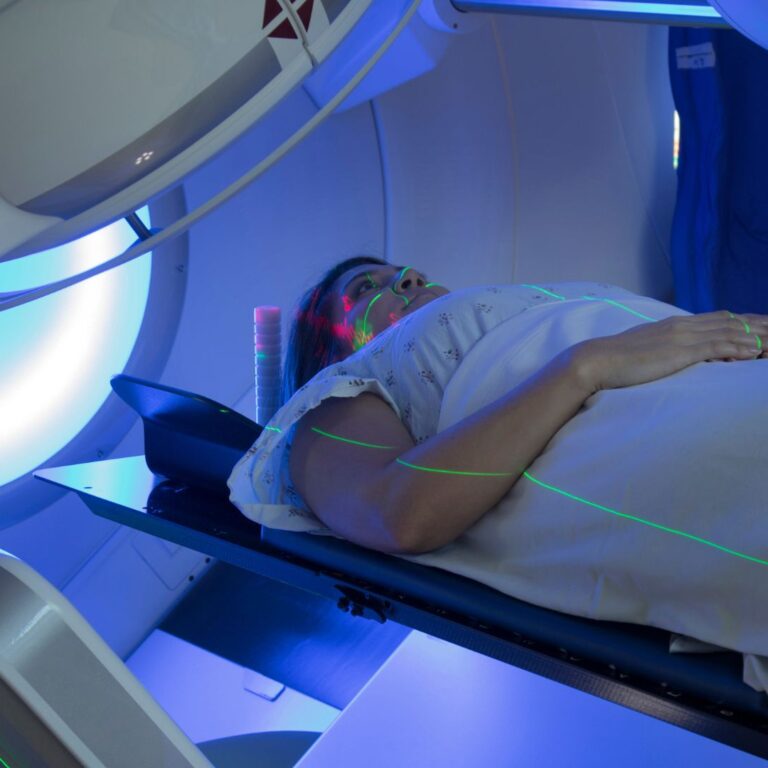Both proton beam therapy and traditional photon radiotherapy are cancer treatment options that share a common goal of targeting and eliminating cancerous cells. However, there are some differences in how they work and their side effects.
Traditional photon radiotherapy uses x-rays to treat tumours. These high-energy x-rays can extend beyond the tumour, affecting healthy tissue nearby and as it exits the body.
Proton beam therapy, on the other hand, is a type of radiotherapy that uses high-energy proton particles to target tumours very precisely. These protons stop just beyond the tumour, so reducing dose and potential damage to nearby normal tissues.
Let’s delve into the nuances of these treatments to understand their differences and effectiveness.
Is Proton Beam Therapy the same as Photon Radiotherapy?
Proton Beam Therapy (PBT) and photon radiotherapy are both types of external beam radiation therapy, but they are not the same. The main difference lies in the type of radiation used and how it interacts with tissues in the body.
Proton beam therapy is a type of radiation therapy that has been proven to effective and advantageous in treating some forms of cancer.
Proton Beam Therapy:
- Utilises protons which are positively charged, high-energy particles, to deliver radiation to the tumour.
- Protons have a unique physical property called the Bragg peak, allowing them to deposit most of their energy directly within the tumour and then stop, rather than extend beyond it, thereby minimising damage to surrounding normal tissues.
- Based on their physical mass and energy, it is possible to stop proton particles at a certain depth inside the body, which means there is no exit dose.
- This precise targeting is especially beneficial when treating tumours near critical structures or in children, where reducing the dose to healthy tissue is crucial.
Photon Radiotherapy:
- Uses high-energy radiation beams, such as x-rays or gamma rays, to target and destroy cancer cells or shrink tumours.
- Regular radiation treatment uses photons in high doses. They do a great job of damaging cancerous cells, but by their nature, they keep moving and once inside the body, they continue to travel through tissues until they exit the body.
- While effective in treating cancer, traditional photon radiotherapy may cause collateral damage to nearby healthy tissues, leading to potential undesirable side effects.
At a glance: Proton Beam Therapy
Proton beam therapy uses protons rather than traditional photons to target tumours.
Because of their unique physical properties, protons can be precisely controlled to deposit their maximum energy within the tumour, while minimising dose and damage to surrounding healthy tissues.
By sparing healthy tissue, proton beam therapy has the potential to reduce the risk of side effects and improve patient outcomes. Reducing long-term side effects is particularly important for children and younger patients.
This precision is particularly advantageous when treating tumours near critical structures or vital organs, where minimising long-term side effects is crucial. This may allow delivery of a higher dose of radiation to the tumour which may increase the chances of curing it.
Effectiveness of proton beam therapy
Studies have shown that patients treated with proton beam therapy can achieve comparable or sometimes even superior tumour control rates to traditional photon radiotherapy, especially for certain types of cancer, such as the base of skull, brain and spinal tumours. The ability to deliver higher doses of radiation to the tumour while sparing nearby healthy tissue contributes to its effectiveness.
Proton beam therapy is a vital tool in helping to treat cancers where a tumour is close to organs such as the brain, spinal cord, salivary glands, lungs, heart, bladder and bowel. This is important for many cancers, including head and neck cancers, prostate cancer, and spinal and brain cancers.
Not all cancers can currently be treated using proton beam therapy, but the range of clinical indications is growing as experience, availability, and cost-effectiveness improve in the UK and across the globe, making it more accessible to patients diagnosed with cancer.
While proton beam therapy is often used on its own, it can be used in conjunction with other therapies, such as surgery and chemotherapy.
The success rate of proton beam therapy
The success rates of proton beam therapy treatment vary depending on the type and stage of cancer being treated. However, overall, a growing body of evidence demonstrates excellent outcomes, with high rates of tumour control similar to those seen with photon radiotherapy and often lower incidences of treatment-related complications.
What cancers can proton beam therapy treat?
Proton beam therapy can be used to treat a wide range of cancers. At the moment, these include some paediatric cancers, prostate cancer, head and neck cancer, brain and base of skull tumours, spinal tumours, some sarcomas, breast cancer and lung cancer.
Side effects of proton beam therapy
The side effects of proton treatment can vary depending on factors such as the type of cancer being treated, the location of the tumour, the dose of radiation administered, and individual patient factors.
However, compared to traditional radiotherapy, proton beam therapy often results in fewer side effects, particularly in the long term, due to its precise targeting of the tumour and reduced exposure to surrounding healthy tissue.
Common acute side effects may include fatigue, nausea, and skin inflammation and irritation, which usually resolve shortly after treatment completion.
To learn more about proton beam therapy, read our guide.
At a glance: Traditional Photon radiotherapy
Traditional photon radiotherapy aims to destroy cancer cells or shrink tumours by using high-energy radiation beams, such as x-rays or gamma rays. It works by damaging the DNA within cancer cells enough to prevent them from dividing and growing, resulting in cell death.
What stage of cancer is radiotherapy used?
Radiotherapy can be employed at various stages of cancer treatment, from early to advanced cancer, depending on the type and location of the tumour. It may be used as the primary treatment or in combination with other therapies, such as surgery or chemotherapy.
Effectiveness of radiation therapy
Radiotherapy has been a cornerstone of cancer treatment for decades and has proven to be highly effective in controlling localised tumours, particularly when surgery is not feasible or as an adjuvant treatment following surgery to target and destroy any remaining cancer cells.
The success rate of radiotherapy
The success rates of radiotherapy treatment in patients with cancer vary depending on factors such as the type, stage, and location of the cancer.
Overall, radiotherapy has been demonstrated to be effective for many cancers, with favourable outcomes in achieving tumour control and improving patient survival rates.
What cancers can radiotherapy treat?
Radiotherapy can be used to treat many types and stages of cancer, ranging from early-stage localised tumours to locally advanced and metastatic disease. It is commonly employed to treat breast, lung, prostate, cervix, head and neck, and various other cancers.
Side effects of radiotherapy
Traditional photon radiation may cause side effects such as fatigue, skin irritation, hair loss, nausea, and damage to surrounding tissues. The severity and duration of these side effects depend on factors such as the dose and duration of treatment and the patient’s overall health.
However, there have been many advances in the way that radiation treatment is delivered, such as intensity modulated radiation therapy (IMRT) which helps limit damage to healthy cells and reduce side effects.
Which cancer treatment is considered safer?
Both proton beam therapy and photon radiotherapy are safe treatments, as care is taken by the radiation oncologists and physicists/dosimetrists in planning the treatment to ensure that doses to normal tissues are kept to safe limits.
However, in some cases, proton beam therapy is better able to do this while still delivering the optimal radiation dose to the tumour. This, in turn, may mean that proton beam therapy treatments are associated with fewer long-term side effects.
Contact Proton International London today for more information
Proton International London offers private proton beam therapy in central London. It is a joint venture between Proton International and University College London Hospitals NHS Foundation Trust.
Proton International London uses a state-of-the-art proton beam therapy system to treat a variety of cancers, including some paediatric cancers, prostate cancer, head and neck cancers, brain tumours, spinal tumours, breast cancer and lung cancer.
Proton beam therapy can often reduce the radiation dose to normal tissues more effectively than conventional photon radiotherapy, which can lead to fewer long term side effects for patients.
Our proton beam therapy consultants are highly skilled and experienced, and have received extensive specialist training to provide safe and accurate delivery of proton beam therapy for our patients. We are also home to some of the country’s leading cancer experts and radiation oncologists involved in cutting-edge research and clinical trials.
It can help to talk to one of our consultants to learn more about our proton beam therapy treatments. Contact us today. We will happily answer any questions and our health care team will determine if proton beam therapy suits your cancer care needs.
Conclusion
While both photon radiotherapy and proton beam therapy treatments are effective in treating cancer, proton beam therapy is gaining credibility due to its precision and its potential to mitigate side effects, making it a promising option for cancer patients.
Frequently asked questions

This article has been clinically reviewed by Proton International Medical Director and Consultant Clinical Oncologist, Dr Beatrice Seddon. Dr Seddon specialises in the use of radiotherapy (including proton beam therapy) and chemotherapy for the management of soft tissue and bone sarcomas.





